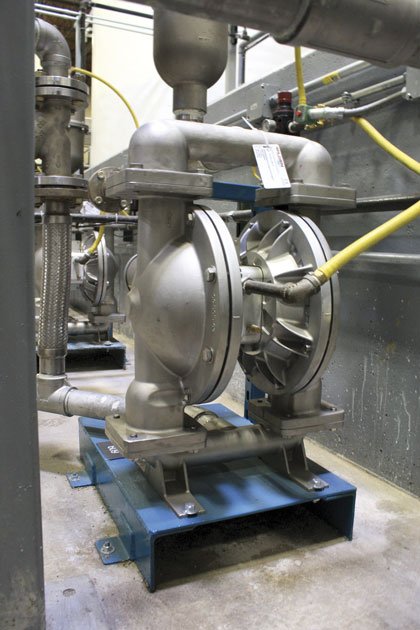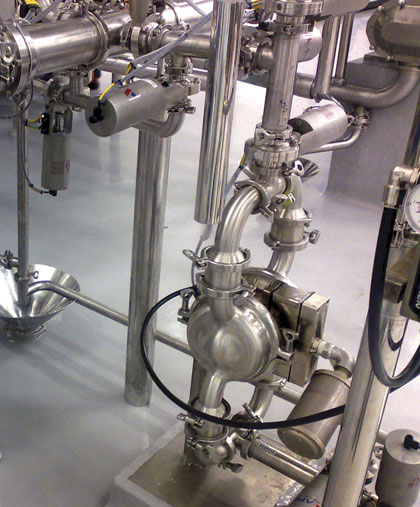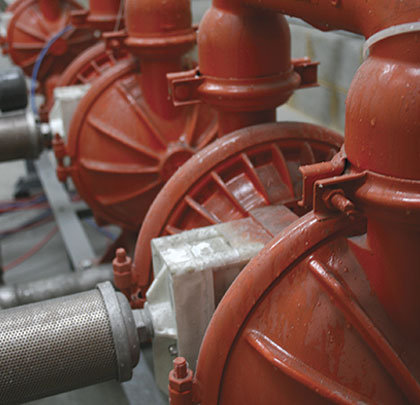There’s no question that the improvements in overall AODD pump operation and ADS capabilities have been significant over the years, and the same can be said for diaphragm materials and design. As AODD pumps have begun to be used in more process-type applications the advances in diaphragm performance have kept pace.
DISCUSSING DIAPHRAGMS
Correct diaphragm material selection is critical to ensure safe AODD pump operation, with six primary factors to consider when choosing a diaphragm: chemical compatibility, temperature range, abrasion resistance, flex life, performance, and cost. To help meet these diverse operational criteria, the number of effective diaphragm materials has also grown and now consists of three basic subsets: Synthetic rubber (Neoprene, Buna-N, EPDM, and Viton®), thermoplastic elastomers (TPE) (polyurethane, Santoprene®, Hytrel®, and Geolast®), and Polytetrafluoroethylene (PTFE or Teflon®). Manufacturers have experts on hand to help pump users select the best diaphragm material and design for their applications.
Advances have also been made in diaphragm design that help make the AODD pump more hygienic in its operation, which allows its use in contamination-sensitive manufacturing applications like food and beverage, pharmaceutical, and personal care. Integral piston diaphragm designs place the shaft connecting plates within the diaphragm itself, which means that all product-entrapment areas and leak points between the piston and diaphragm have been eliminated, resulting in a reduction in the chance that product contamination or leaks can occur. Integral piston diaphragms are also easily cleanable and there is no interaction between the diaphragm and the outer piston plate that can lead to abrasive diaphragm failure. For the chemical facility operator, downtime and pump maintenance are typically more expensive than the spare parts required to keep the AODD pump operating. This allows the pump to run twice as long before requiring maintenance and will translate directly to a healthier bottom line.
In general, standard AODD pump builds that feature PTFE diaphragms have a Neoprene backup for reduced-stroke configurations and a Santoprene backup in full-stroke configurations. Santoprene is actually an excellent backup choice for both reduced- and full-stroke diaphragm configurations since it has excellent chemical-resistance properties and long flex life. Another option is Hytrel® backup diaphragms; this material has the lowest compression set of any elastomer in use and performs well in sealing the diaphragm at the inner/outer piston interface and the outside diameter bead.
CHEMICALLY SPEAKING
So, what does all this mean for the chemical-processing industry? By definition, chemical manufacture features some of the most intricate and complex industrial processes in the world. The complexity of chemical manufacture is highlighted by the number of so-called “unit operations” that must be completed during the overall manufacturing process.
One of the most critical of these unit operations is the transfer of liquids along the production chain. Because of the importance of the myriad transferring operations within the entire chemical-manufacturing process–raw materials to storage tanks, raw materials to blending tanks, finished products into fixed-weight containers, etc.—facility operators need to identify the best pumping technology for the job, one that possesses the versatility to perform reliably and efficiently at any number of points in the production hierarchy.
It had almost become a rote choice among chemical manufacturers that centrifugal pumps were the best technology for transfer operations within the chemical plant, for several reasons:
- Centrifugal pumps work best with thin, water-like fluids, which have long been a staple in chemical manufacturing
- A kind of “if it ain’t broke don’t fix it” attitude has made the centrifugal pump an easy fallback option for operators who have undoubtedly worked with the technology at some point in their careers
- There was an overriding perception that centrifugal pumps have a lower operating cost when compared to the operations of an AODD pump, but this has been shown to not necessarily be the case.
A closer look, though, shows that despite its reputation, the centrifugal pump doesn’t appear to be the all-conquering technology that is required for efficient and optimized chemical-processing applications.
Specifically, centrifugal pumps work best when they are operated at their Best Efficiency Point (BEP). Unfortunately, that BEP is rarely realized for an extended period of time during fluid-transfer operations, which results in flow rates that can fluctuate constantly.
Additionally, consistent operation off the BEP can lead to potential problems, not only from the equipment’s operational point of view, but also in regard to the production process and the way the chemical is formulated.
Also, when a centrifugal pump operates to the left of its BEP, radial loads increase due to the way the pump generates pressure along its volute by reducing the fluid velocity. This method of operation increases shaft deflection at the seal faces, which results in increased seal wear and a decrease in the pump’s life expectancy. Working to the left of the curve will also increase axial loads that can overload the thrust bearings, especially in open-impeller and diffuser-type multi-stage centrifugal pumps. Finally, as a centrifugal pump operates close to the zero-flow point (zero efficiency), heat will be generated at levels that can be highly harmful to heat-sensitive chemicals or products themselves, which can also adversely affect safety and the quality of the resulting product.
At the other end of the spectrum, when a centrifugal pump works to the right of BEP other problems can be created. Specifically, the level of net positive suction head (NPSH) required increases, which may cause efficiency-harming cavitation to occur. Since the liquid-transfer process in the chemical industry, particularly when handling specialty chemicals, is managed in batches, an insufficient NPSH condition may be more complicated to detect, but it will deteriorate the pump’s operational capabilities continuously, meaning that the pump’s ability to handle any cavitation that occurs will be compromised.
By comparison, the fluid-delivery curve for an AODD pump is very similar to that of the centrifugal unit, without the negative behavior that occurs when running off the BEP. The AODD pump will perform based on the inlet air pressure supplied to the pump and the system pressure it encounters. If adequate suction pressure is available, fluid will flow into the pump and be discharged based on the relationship between the air pressure operating the pump and the system pressure.

Featured Image: Critical operational characteristics such as the ability to self-prime, run dry, maintain suction lift over long stretches, withstand deadhead conditions, operate while submerged and pass large solids make Wilden® AODD Pumps ideal for use as process pumps in chemical-manufacturing applications.
Above: Wilden® Advanced™ Series FIT AODD Pumps feature optimized flow paths for reduced air consumption and can be easily dropped into existing footprints.
The larger this pressure differential is, the faster the pump will operate, and when the differential is reduced, the pump’s operation will slow. This is referred to as “infinitely variable speed operation.” If the system pressure should increase unexpectedly, the pump will operate until the inlet air and system pressure are equal, at that time the AODD pump will stop–in what is termed a “deadhead” condition—with no equipment damage. The system remains pressurized, but no differential pressure exists to continue driving fluid. The pump will restart when the system pressure falls below the operating air pressure, which is particularly important in batch processes.
In contrast, a closed valve can wreak havoc on a centrifugal pump, and with different positive displacement pump technologies operating against a closed valve can cause damage or destroy a system by reaching the burst pressure of the plumbing in very short order.
If a valve is restricted on the inlet side of a centrifugal pump, the pump can cavitate, leading to impeller and volute damage. If the inlet were closed completely, the operator should expect bearing and wear-ring failure due to heat buildup. If this condition occurs when operating an AODD pump, the pump will slow and if the inlet were closed completely, the pump would stop, waiting for the inlet line to be open once more when it would resume its pumping operations.
In summation, AODD pumps can match the supposed advantages that centrifugal pumps may have while also shining an even brighter spotlight on the centrifugal pump’s troubling operational disadvantages:
- AODD pumps are eminently appropriate for use with liquids with high viscosity and can easily move fluids that range from water-like liquids to medium and very viscous liquids.
- AODD pumps are fool-proof and can run dry and strip discharge lines without getting damaged; if the pressures get to be too much, the pump will just stop running, but won’t break. On the other hand, centrifugal pumps can’t run dry and when extra pressure is created, their seals, bearings, and piping can break, which leads to added downtime and repair costs, as well as increased safety risks for plant personnel.
- AODD pumps are simple devices and controlling accessories consist of solenoid operators, pump-cycle counters and surge-dampener assemblies.
Operating costs can be similar when all the maintenance, accessories and controllers are evaluated, and in many cases, the total cost of ownership is lower over the operational lifespan of an AODD pump when compared to a centrifugal model.

The Pro-Flo® SHIFT air distribution system (ADS) from Wilden® takes AODD pump operation to the next level as its innovative air control spool helps reduce air consumption by up to 60 percent when compared with competitive ADS technologies.
CONCLUSION
From its inception, the industrial pump has faced the same demand from its operators: perform its duties reliably and with a limited amount of downtime and ancillary repair or replacement costs. Thanks to its simple, yet innovative, design the AODD pump has been able to consistently meet those demands and has become a go-to pumping technology where basic liquid-transfer capabilities are required. Times change, however, and today it is not only enough to perform the required task, now the pump must do so in the most cost-effective and environmentally friendly way possible, with the lowest effect on the bottom line and carbon footprint resulting.
That creates a quandary for the chemical manufacturer who must perform that cost and environmentally sensitive juggling act while still creating products that are some of the most complex and intricate in the industrial-manufacturing universe. Many have found that relying on previously tried-and-true pumping technologies may not be enough anymore and have begun to look for alternatives. Ready to step into the chemical-processing breach is the AODD pump, which possesses a stable of enviable operational characteristics–dry-run capability, high suction lift, particulate-handling, to name a few–that can make it the ideal choice for chemical manufacturers who are searching for a pump technology that meshes cost-conscious energy consumption with streamlined flow rates.
About the Author
Edison Brito is the global sales director, diaphragm equipment for Wilden® and PSG®. He can be reached at 973.780.7985 or edison.brito@psgdover.com. Rob Jack is a development engineer IV for Wilden® and PSG®. He can be reached at 909.422.1784 or rob.jack@psgdover.com. Based in Grand Terrace, California, Wilden is the global leader in air-operated double-diaphragm (AODD) pumps and a product brand of PSG, a Dover company. Headquartered in Oakbrook Terrace, Illinois, PSG is comprised of several of the world’s leading pump brands, including Abaque®, Almatec®, Blackmer®, Ebsray®, Griswold™, EnviroGear®, Mouvex®, Neptune™, Quattroflow™, RedScrew™, and Wilden®. For more information, visit www.wildenpump.com or www.psgdover.com.
____________________________________________
MODERN PUMPING TODAY, September 2017
Did you enjoy this article?
Subscribe to the FREE Digital Edition of Modern Pumping Today Magazine!



